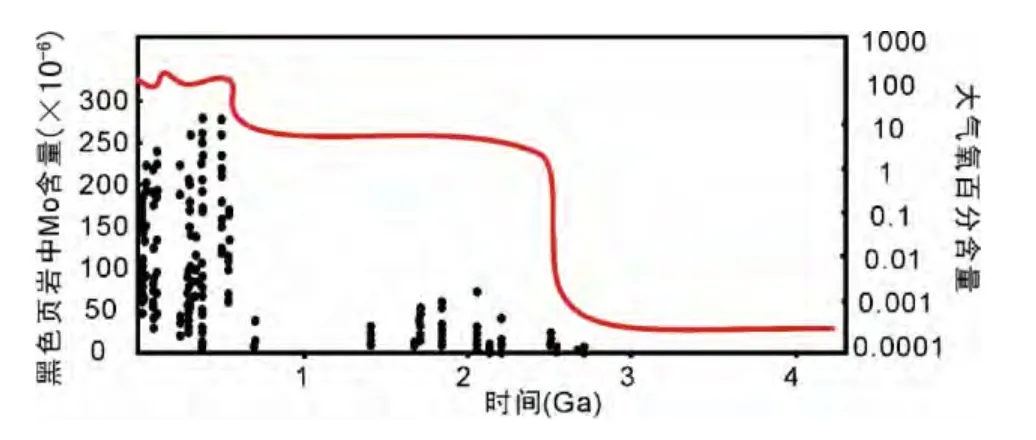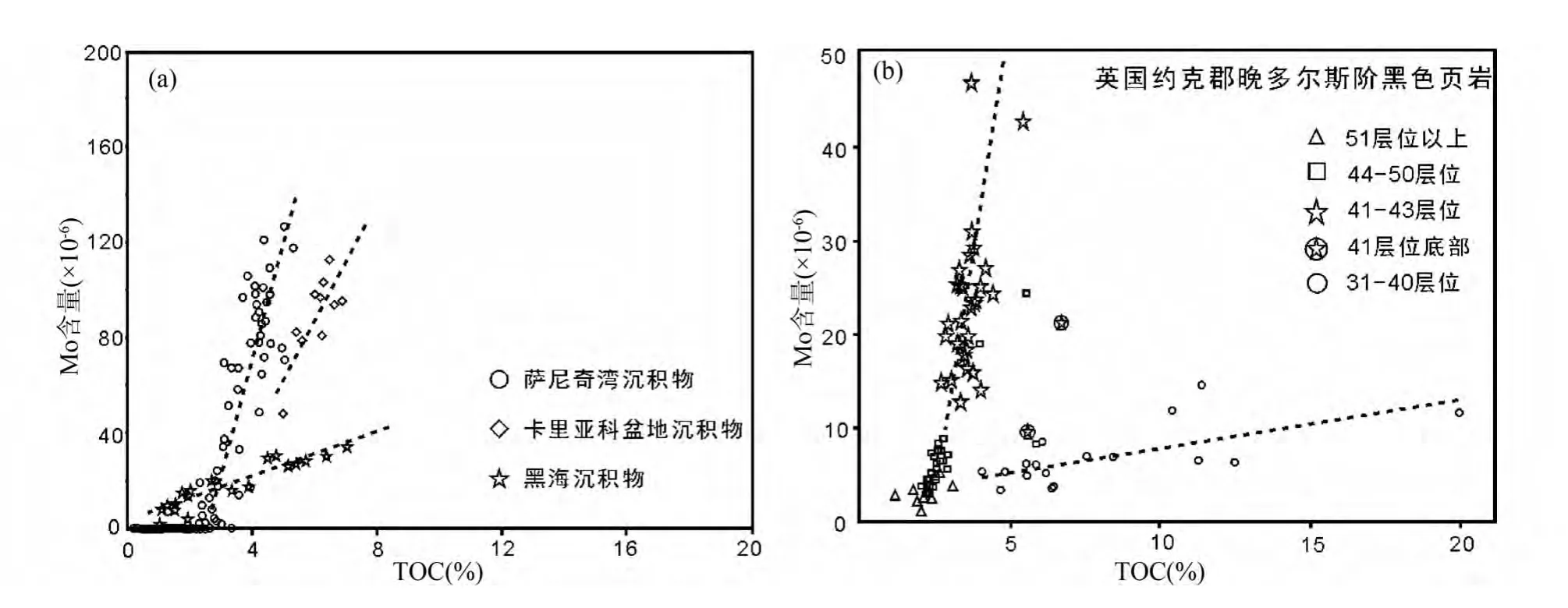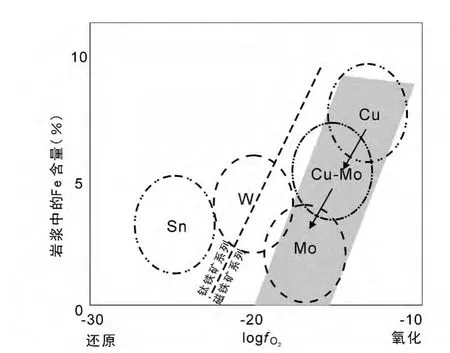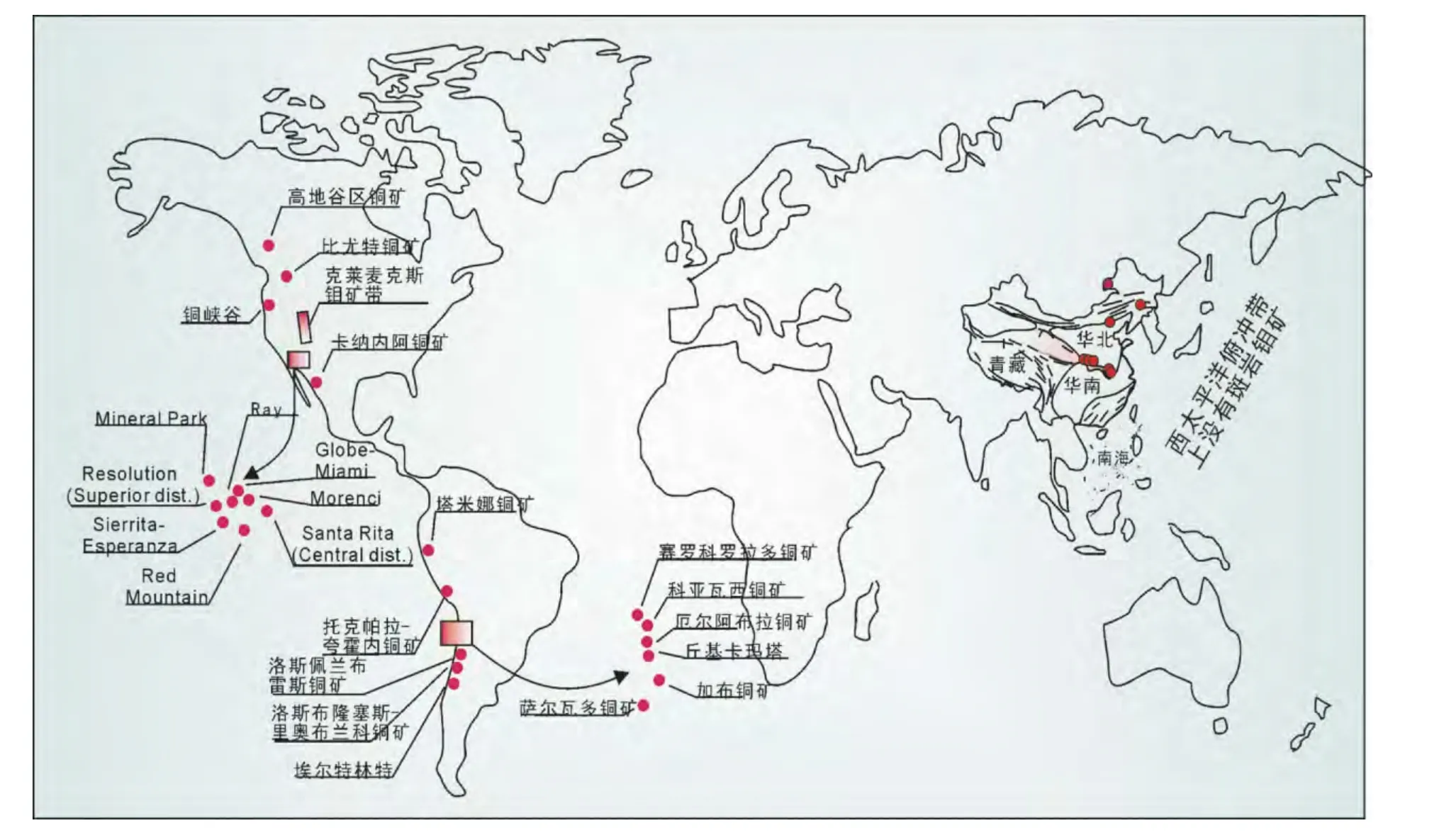钼的地球化学性质与成矿*
孙卫东 李聪颖 凌明星 丁兴 杨晓勇 梁华英 张红 范蔚茗
1.中国科学院广州地球化学研究所,中国科学院矿物与成矿重点实验室,广州 510640
2.中国科学院青藏高原地球科学卓越创新中心,北京 100101
3.中国科学院广州地球化学研究所,中国科学院同位素年代学和地球化学重点实验室,广州 510640
4.中国科学技术大学地球和空间科学学院,合肥 230026
5.西北大学地质学系,西安 710069
1 引言
钼(Mo)是一种中度不相容的亲铜元素,在MORB 和弧后盆玄武岩的岩浆作用中其不相容性与铈(Ce)和锶(Sr)等元素相似(McDonough and Sun,1995;Sun and McDonough,1989)。由于Mo 具有亲铜性质,在岩浆过程中的不相容性受到硫在岩浆中饱和程度的影响(Sun et al.,2003b),所以Mo与Ce 具有相似的不相容性属于偶然结果。与同为亲硫元素的铜(Cu)、铼(Re)相比,Mo 的不相容性略高(Sun et al.,2003a,b,2004)。Mo 是一种十分稀有的元素,在原始地幔中的丰度为50 ×10-9,仅为稀土元素Ce 原始地幔丰度的3%,Cu 的0.13% (McDonough and Sun,1995)。钼在大陆地壳中的丰度为0.8 ×10-6,相应地为Ce 陆壳丰度的2%,Cu的3% (Rudnick and Gao,2003)。虽然Mo 在原始地幔和陆壳中的丰度均很低,但与其它丰度很低的元素不同,Mo 是一种重要的成矿元素。在自然界中,Mo 常以辉钼矿的形式产出,有大量的钼矿床,主要是斑岩钼矿和斑岩铜(金)钼矿;相比之下,Ce 很少形成独立的矿物和矿床。这种特殊的地质表征暗示钼元素在地质过程中有着独特的富集机制和成矿过程。
本文尝试通过分析Mo 的地球化学性质来理解其富集机制和成矿过程,探讨不同富集机制及相应矿床特点。
2 钼的地球化学性质与富集机制
钼的富集主要包括两个过程,即表生过程和岩浆过程。
2.1 表生过程
根据Mo 的地球化学性质,有利于提高沉积物中Mo 含量的关键因素有:高大气氧含量、高化学风化速率、大流域面积、河口地区和还原性沉积环境。化学风化速率主要受控于气温和降水,通常降雨量大的热带地区是化学风化速率最高的气候带(Ma et al.,2007),亚热带次之,温带、寒带的化学风化速率通常远低于热带、亚热带。另一方面,造山带由于快速抬升,风化剥蚀速率往往远高于相同气候带的其它大地构造位置,因此处于热带、亚热带的造山带是全球化学风化最强烈的地区,相应地释放出更多的钼。

图1 黑色页岩中钼含量和大气氧含量随时间的变化在2.3Ga 左右,大气氧第一大幅度升高(Kump,2008),但是此次升高没有对沉积物中Mo 含量产生明显的影响(Scott et al.,2008).在寒武纪/前寒武纪之交,大气氧含量再次升高(Kump,2008),黑色页岩等沉积物中Mo 的含量大幅度升高(Scott et al.,2008).富钼黑色页岩部分熔融有利于钼矿床的形成Fig.1 Variations of Mo contents in black shales as a function of atmospheric oxygenThe first elevation of atmospheric oxygen in the Earth’s history occurred at~2.3Gyr ago (Kump,2008),which however,did not result in elevation of Mo in black shales (Scott et al.,2008).After the second major elevation of atmospheric oxygen at~550Myr ago,Mo contents in black shales increased dramatically (Scott et al.,2008).Partial melting of Mo rich black shales are favorable to Mo deposits
还原水体是钼表生过程中富集的另一个关键因素,封闭、半封闭型水域往往会形成还原性水体,可以还原、吸收水体中的钼等变价元素,形成富钼黑色页岩等沉积物(岩)。在同一地区的沉积物中,Mo 含量与沉积物中有机碳的含量(Corg)有正相关关系(图2)(Rimmer,2004)。值得注意的是不同的沉积物中钼含量差异很大,从几个到几百个×10-6(Rimmer,2004;Scott et al.,2008),其含量总体上与沉积物中有机碳含量往往呈正相关关系,但是在有机碳对钼含量的图解中,不同环境下形成的沉积物有不同的斜率(图2)(Algeo and Lyons,2006;McArthur et al.,2008;Rowe et al.,2008),这可能反映了Mo 沉积时水体的氧化还原条件,或者与其源区的Mo/Corg等有关。
一般说来,沉积物中钼含量与大气氧含量、化学风化强度、沉积环境等有着密切的关系。板块俯冲、碰撞往往形成造山带,大幅度提高风化速率;与此同时,还往往在弧后等环境形成封闭、半封闭水体,有利于形成钼富集的还原性沉积物。因此,位于热带、亚热带的陆缘弧是表生过程中钼富集的最佳环境,其富集量取决于流域面积和持续时间等;而河流是地表径流入海的主要通道,因此河口地区更有利于富钼黑色页岩等沉积物的形成。
值得指出的是,在地球历史上曾发生过多次全球性大洋缺氧事件,还原性水体在开阔性大洋也普遍存在,例如全球水域广泛发育黑色页岩等富含有机质的沉积岩(Bralower et al.,1999;Suan et al.,2010)。在这种情况下,形成富钼黑色页岩等沉积物的关键在于化学风化速率和陆源物质输送量。其中,白垩纪的全球性海洋缺氧事件规模大,是国际上地球科学研究的热点之一(Bralower et al.,1999;McElwain et al.,2005;Wang et al.,2001;Wilson and Norris,2001)。现有数据显示白垩纪大洋缺氧事件所形成的黑色页岩中往往富集钼(Berrocoso et al.,2008;Lipinski et al.,2003;Turgeon and Creaser,2008),这些黑色页岩可能是东太平洋沿岸铜(金)钼矿发育的主要原因。

图2 钼与还原性沉积物中有机碳含量的关系(a)显示了萨尼奇湾、卡里亚科盆地和黑海沉积物不同的钼含量与有机碳含量及其相关性图,同源样品表现出较好的相关性,其斜率可能取决于陆源输入物的Mo/TOC 比值(Algeo and Lyons,2006);(b)显示了英国约克郡晚多尔斯阶黑色页岩不同层位具有不同的钼含量与有机碳含量,其相关性也有明显变化.可能说明了当时海洋发生了氧化还原事件或者源区发生了变化(McArthur et al.,2008)Fig.2 Molybdenum contents versus total organic contents (TOC)in black shales(a)parsed Mo-TOC data for modern anoxic silled-basin environments.These exhibit a well-defined relationship between Mo and TOC concentrations in the same place,suggesting a similar Mo/TOC source (Algeo and Lyons,2006).(b)crossplot of Mo-TOC data in Lower Toarcian sediments of Yorkshire,United Kingdom.The obvious different slopes the two regression lines may reflect different redox states or source regions (McArthur et al.,2008)
2.2 岩浆过程
经历表生富集过程形成的富钼沉积物(岩)通常不会直接达到工业品位而成矿。目前已知的含Mo 最高的黑色页岩是华南寒武纪底部的镍钼层,其Mo 含量达到5.5%以上,远远超过了工业品位,但是其成因是简单的沉积过程还是有热液活动参与还存在争议(Jiang et al.,2009;Mao et al.,2002;Wille et al.,2008)。一种可能是当时氧逸度突然上升,使钼大量被氧化,搬运到还原水体沉积。通常富钼黑色页岩需要在适当条件下发生部分熔融,使钼进一步富集,才能成矿。富钼沉积物(岩)发生部分熔融的主要途径有两个,即板块俯冲和深埋升温。
板块俯冲过程中,随着温度的升高,沉积物发生一系列的变质作用、释放出挥发份(如水、有机物等),很多还原性物质可能在俯冲的早期就释放了。造山带地幔方辉橄榄岩中发现的富含甲烷的流体包裹体(Song et al.,2009)可能就是这个过程中形成的。随着还原性物质的释放,俯冲沉积物的氧逸度会逐渐升高。当俯冲到较大的深度时,沉积物会发生部分熔融,形成富钼初始岩浆。由于上述岩浆形成于俯冲板片的表层,在上升过程中要穿过地幔楔,因此往往与岛弧岩浆发生不同程度的混合。此外,钼也可能会通过脱水直接进入岛弧岩浆。岛弧岩浆岩的氧逸度通常高出地幔1~2 个数量级以上(Ballhaus,1993;Bryant et al.,2007;Sun et al.,2004,2007),因此混合后岩浆的氧逸度会进一步升高。与此同时,俯冲板块(玄武岩)部分熔融等过程会形成富集铜、金的埃达克质岩石(Kay et al.,2005;Mungall,2002;Oyarzun et al.,2001;Sajona and Maury,1998;Sun et al.,2010,2011,2013b,2014,2015;Thiéblemont et al.,1997),因此,与板块俯冲有关的钼矿可以与铜、金等元素共生,形成铜钼矿床或铜金钼矿床。还原性沉积物的初始低氧逸度可能是造成俯冲带斑岩铜(金)钼矿床氧逸度系统低于斑岩铜(金)矿床的原因(图3)。由于混合作用,斑岩铜钼矿的Mo品位通常远远低于斑岩钼矿(Klemm et al.,2008)。
在深埋的过程中,随着温度的升高,富钼黑色页岩等沉积岩也要发生变质作用,释放出挥发份,包括有机质等还原性物质。值得指出的是,深埋过程的地温梯度往往高于俯冲过程,其变质过程中容易释放负二价的硫:当变质达到角闪岩相时,黄铁矿在高温下变质成磁黄铁矿,沉积岩会释放出H2S (Tomkins,2010)等还原性物质及金等亲硫元素(Sun et al.,2013a),其氧逸度会进一步升高。当温度升高到固熔线以上时,沉积物会发生部分熔融,形成的富钼初始岩浆,有利于形成斑岩钼矿。此类矿床倾向于富集高度不相容亲石元素,如钨,从而形成钨钼共生的矿床类型,如秦岭的上房沟(包志伟等,2009)和三道庄矿床(Zhang et al.,2011;石英霞等,2009)。由于在这个过程中没有岛弧岩浆岩的参与,因此,斑岩钼矿的氧逸度通常比较低,系统低于斑岩铜钼矿床和斑岩铜金矿床(图3)。深埋变质的黑色页岩能否形成斑岩矿床,关键是氧逸度。

图3 氧逸度与成矿图(据Thompson et al.,1999;Sillitoe and Thompson,1998)从斑岩铜金矿床→斑岩铜(金)钼矿床→斑岩钼矿,氧逸度和铁含量逐渐降低.其原因可能与富钼黑色页岩有关Fig.3 FeO versus logfO2 diagram (after Thompson et al.,1999;Sillitoe and Thompson,1998)The decreasing total iron content and logfO2 from porphyry Cu-Au to porphyry Cu-(Au)-Mo to porphyry Mo deposits is likely associated with the involvement of Mo-rich black shales
铁在高氧逸度下的化学风化过程中很不活动(Ma et al.,2007),因此黑色页岩等富钼黑色页岩等沉积岩的铁含量一般较低,相应地其部分熔融形成的岩浆也往往具有较低的铁含量。与富钼岩浆不同,斑岩铜矿往往与俯冲洋壳部分熔融形成的埃达克岩相关(Cooke et al.,2005;Sun et al.,2010,2011;Thiéblemont et al.,1997;Sajona and Maury,1998;Mungall,2002;Xie et al.,2012;Zhang et al.,2013),由于洋壳的铁含量高(Sun and McDonough,1989;Sun et al.,2008),此类斑岩的铁含量要系统高于富钼斑岩。而铜钼矿床作为两者的混合,铁含量也位于两者之间。这样就形成了从斑岩铜金矿床→斑岩铜(金)钼矿床→斑岩钼矿氧逸度和铁含量均逐渐降低的现象(图3)。由于岩浆混合,斑岩铜(金)钼矿中钼的品位通常低于斑岩钼矿。
在俯冲过程中氯有很强的活动性(Lassiter et al.,2002;Rowe and Lassiter,2009;Sun et al.,2007)。与氯不同,在板块俯冲初期,氟会大量进入多硅白云母、磷灰石等矿物,而表现出不活动的特点,因此与板块俯冲有关的钼矿(斑岩铜钼矿)可能与氯有较强的亲缘关系,与氟关系不明显(Zhang et al.,2013)。相反,没有经过板块俯冲,直接通过深埋等过程升温发生部分熔融时,所形成的岩浆往往具有较高的氟,与氟有较好的亲缘性。而位于弧后多硅白云母分解区之上的深埋或者俯冲变质黑色页岩部分熔融型斑岩钼矿可能具有很高的氟,如美国的Climax 钼矿带。值得指出的是,氟与钼具有很好的亲和性,对钼的进一步富集可能有促进作用。
研究表明,斑岩矿床通常都具有很高的氧逸度。斑岩钼矿床也是如此(Sun et al.,2013b,2014,2015)。富含有机物的沉积物是还原性的,如何由还原性变为氧化性是一个值得研究的课题。

图4 环太平洋地区斑岩铜(金)钼矿分布(据Sillitoe,2010,有改动)太平洋东岸有大量的斑岩铜(金)钼矿床,太平洋西岸几乎没有斑岩铜(金)钼矿床,其原因是俯冲体制Fig.4 The distribution of porphyry Mo deposits along the Pacific margins (modified after Sillitoe,2010)There are large amount of porphyry Cu (Au)Mo deposits along the eastern Pacific margins,whereas there are essentially no porphyry Cu(Au)Mo deposits along the western Pacific margins.This is likely due to different subduction regimes
3 世界重要钼矿带的成因初探
3.1 太平洋沿岸钼矿带
从成矿的角度看,太平洋东西两岸差别很大。东岸有大量的斑岩铜金矿床,而西岸则只在菲律宾、印尼等岛国有斑岩铜金矿床,但是规模远小于东岸,而数千千米长的日本岛弧几乎没有斑岩铜金矿床,这种现象被认为是太平洋俯冲不对称的结果(Sun et al.,2010),东岸靠近太平洋扩张洋脊,北部扩张洋脊已经消亡(Cole and Basu,1995;Cole et al.,2006;Cole and Stewart,2009),南部也有大量的垂直于主扩张洋脊的扩张洋脊和非震洋脊(aseismic ridge)俯冲(Cooke et al.,2005;Espurt et al.,2008;Sun et al.,2010)。斑岩钼矿的分布有类似的特点(图4),太平洋东海岸钼矿资源很丰富,美国的阿拉斯加、华盛顿、爱达荷、内华达、科罗拉多、新墨西哥、犹他、亚利桑那、蒙大拿等州广泛发育斑岩钼矿和斑岩铜钼矿床。智利的埃尔特林特(El Teniente,9435 万吨铜,250 万吨钼,437 吨金),丘基卡马塔(Chuquicamata,6637 万吨铜,181 万吨钼,300 吨金)和Río Blanco-Los Bronces(5673万吨铜,126 万吨钼,244.7 吨金)(Cooke et al.,2005)是世界上最大的三个斑岩铜金矿床,伴生钼储量达到550 多万吨,占智利的钼储量约85%以上。加拿大的不列颠哥伦比亚省有很丰富的钼矿床,占加拿大钼资源的80%左右。上述矿床大部分为原生斑岩型钼矿床及斑岩型铜(金)钼矿床。造成上述钼矿分布特点的主要原因是东、西太平洋俯冲体制的差异。

图5 太平洋东西两岸俯冲体制差异示意图东太平洋俯冲带是陆缘俯冲带,发育陆缘弧,陆源沉积物可以堆积在俯冲板片上,沉积物中钼含量高.一部分可以被俯冲板片带到地球深部,有利于钼矿的形成.西太平洋俯冲带是岛弧俯冲带,发育岛弧,陆源沉积物主要堆积在弧后盆中,俯冲板片上富钼沉积物少,不利于形成钼矿Fig.5 Cartons showing the differences in subduction regimes between the eastern and western Pacific marginsFlat subduction with continental margin arc in the east versus steep subduction with backarc basin in the west.Backarc basins in the West Pacific may have filtered Mo,Re as well as nutrients,forming less Mo enriched sediments, which is not favorable for Mo mineralization
东太平洋俯冲带是陆缘俯冲带,发育陆缘弧;西太平洋俯冲带是岛弧俯冲带,发育岛弧(图5)。根据钼的地球化学性质,其表生富集过程的关键是陆源物质的输入和还原性水体。东太平洋属于陆缘弧,俯冲带紧邻大陆,俯冲板片上有大量的陆源沉积物,可以随板块一起俯冲到地幔。由于沉积物富硅含水,因此容易发生部分熔融(Plank and Langmuir,1993,1998),其中的富钼黑色页岩等沉积岩会形成富钼岩浆,有利于成矿。而相比之下,西太平洋由于有典型的沟-弧-盆体系,陆源物质优先在弧后盆沉积,尤其是钼等变价元素,通常主要留在弧后盆等富含有机物的沉积物中(Turgeon and Brumsack,2006)(图6)。因此俯冲板片上的沉积物较少,而且沉积物中的钼含量通常远低于陆缘沉积物。这可能是西太平洋斑岩钼矿少的主要原因。

图6 钼富集的沉积环境示意图(据Turgeon and Brumsack,2006 修改)弧后盆等还原性水体发育的构造位置易于出现钼富集Fig.6 Cartons of Mo depositional model (modified after Turgeon and Brumsack,2006)Cartons showing closed or semi-closed water bodies,such as back-arc basin,with large catchment area and high chemical weathering rates are favorable places for the formation of Mo enriched sediments,because of anoxic environment and Mo-rich surface water
值得指出的是,东太平洋的钼矿不仅储量大,而且分布广(图4),在高纬度地区同样发育大量的钼矿。如前述,除了其俯冲体制外,侏罗纪、白垩纪全球大洋缺氧事件形成的富钼黑色页岩等沉积岩的作用可能更大。在全球大洋缺氧事件期间,还原性水体在开阔性大洋也普遍发育,形成的黑色页岩中往往富集钼(Berrocoso et al.,2008;Lipinski et al.,2003;Turgeon and Creaser,2008)。一般认为,全球大洋缺氧事件的起因是二氧化碳升高引起的全球气温突然升高(Jenkyns,2010)。在高温气候条件下,全球化学风化速率普遍升高,不仅位于热带、亚热带的造山带附近海域会形成大量的富钼黑色页岩,高纬度地区的化学风化速率也会很高,有利于形成富钼黑色页岩等沉积岩。其中,白垩纪的全球大洋缺氧事件在全球范围内形成大量的富含有机物的沉积岩,如特提斯(Scopelliti et al.,2006;Turgeon and Brumsack,2006;Wang et al.,2001;Zou et al.,2005)、太 平 洋(Robinson et al.,2004;Takashima et al.,2010)、大西洋(Berrocoso et al.,2008)等,这些沉积岩普遍富钼。目前东太平洋最老的洋壳是古新世,表明白垩纪洋壳已经完全被俯冲消减。尽管其原始分布不是很清楚,但是从现有资料看,在东太平洋,俯冲形成的海岸山脉加大了风化速率,更有利于富钼沉积物的形成。考虑到俯冲体制的差异,有理由推断,东太平洋白垩纪富钼沉积物比西太平洋更发育。这些形成于全球大洋缺氧事件的(富钼)黑色页岩可能是东太平洋沿岸铜(金)钼矿发育的最主要原因。相比之下,西太平洋曾经长期向北俯冲(Sun et al.,2007),在50Ma 是转向北西俯冲,目前俯冲的是侏罗纪、白垩纪洋壳。由于还原性沉积物的影响,西北太平洋的氧逸度系统低于东太平洋,不利于形成斑岩矿床(Sun et al.,2012,2013b)。
除了斑岩铜(金)钼矿床外,美洲还有大量的斑岩钼矿。世界上著名的Climax-Henderson 钼矿带沿东太平洋俯冲带北美科迪勒拉山脉分布,属于典型的斑岩钼矿床,几乎不含铜金,但其Mo 品位远远高于斑岩铜钼矿床,并且有很高的氟含量(Klemm et al.,2008)。铅同位素数据指示其源于地壳(Stein and Hannah,1985)。在白垩世到早第三世期间,该区属于俯冲带海岸山脉与大陆之间的半封闭型海盆,白垩纪高温湿润的气候有利于化学风化,而位于热带、亚热带地区的北美造山带南端化学风化受到高温和造山的双重作用,化学风化理应更强烈,为Climax-Henderson 钼矿带的形成提供了物质基础。这些钼矿不含铜,而具有很高的氟含量(Klemm et al.,2008),可能是富钼黑色页岩等沉积岩在弧后拉张条件下直接部分熔融形成的,其高氟含量可能与俯冲板片上多硅白云母分解有关。一种可能的机制是板片后撤引发软流圈上涌,使俯冲板片的温度升高,多硅白云母集中分解,同时软流圈的加热造成地壳中易熔的富钼沉积物发生部分熔融,形成斑岩钼矿(Li et al.,2012b)。
3.2 秦岭钼矿带
我国的秦岭钼矿带现在是世界著名斑岩钼矿带,目前控制储量已经达到500 万吨以上,约占全国总储量的50% (Li et al.,2007,2012a)。这些钼矿床主要分布于东秦岭华北克拉通南缘二郎坪弧后盆,形成时代以早白垩世为主,有少量晚三叠世(Stein et al.,1997;李永峰等,2005;毛景文等,2005)。最近在大别山北淮阳地区也发现超大型钼矿(Zhang et al.,2014)。整个秦岭大别钼矿带的总储量达到700 万吨以上。这些钼矿的形成时代分为三个阶段:晚三叠、早白垩早期和早白垩晚期(Li et al.,2012a)。一部分学者认为晚三叠世成矿期的脉状矿床都与华北克拉通和扬子克拉通碰撞后的陆内造山局部伸展过程有关;早白垩世早期的成矿作用与依泽纳吉板块和太平洋板俯冲产生的弧后拉张有关;再晚的成矿作用可以归因于中国东部的大规模岩石圈拆沉运动(Mao et al.,2008;毛景文等,2005)。另一种观点认为晚三叠世的矿床形成于弧后拉伸环境,而其后的斑岩型钼矿床都与华北和扬子陆块的碰撞造山过程有关(Li et al.,2007;李永峰等,2005)。世界上的碰撞造山带很多,究竟是什么原因使东秦岭成为世界上重要的钼矿带?
古地磁研究表明,在其演化历史中,秦岭-大别造山带曾长期处于中低纬度(Zhao and Coe,1987;Zhu et al.,1998),符合钼表生富集的主要条件:高化学风化的热带、亚热带和长期演化的造山带。秦岭造山带有着两次主要的碰撞造山事件:古生代沿商丹缝合带的碰撞和三叠纪沿勉略缝合带的碰撞(Meng and Zhang,1999;Qin et al.,2009,2010;Sun et al.,2002a,b;Zhang et al.,1996)。在古生代时,岩相古地理显示商丹缝合线以南曾经形成了向西开口的盲肠状海盆(Yin et al.,2004),属于半封闭型海盆,推测应该发育还原性沉积环境,有利于形成富钼沉积物。二郎坪弧后盆属古生代弧后盆(Li et al.,1996;Meng and Zhang,1999;Sun et al.,2002a,b;Zhang et al.,1996),目前对其演化了解甚少。考虑到其东面的大别造山古生代岛弧发育较差以及碰撞时代东西存在差异(Sun et al.,2002c;Zhai et al.,1998),推测二郎坪弧后盆也曾经历过封闭、半封闭海盆的阶段,有利于形成富钼沉积物。这些富钼沉积物在造山过程中被俯冲或深埋,在适当的条件下形成斑岩钼矿。
秦岭古生代钼矿很不发育,这说明秦岭造山带富钼沉积物在古生代时并没有大量参与岩浆形成。三叠纪秦岭-大别造山带发生了最后一次全面陆陆碰撞形成了著名的桐柏-大别-苏鲁超高压变质带(Li et al.,1994,2000;Li and Rao,1993;Liu et al.,2006;Sun et al.,2002a;Zheng et al.,2003;Ding et al.,2013),西部形成了同造山花岗岩带,年龄在220~206Ma 之间(Jiang et al.,2010;Qin et al.,2009,2010;Sun et al.,2002c;周滨等,2008),但是大多数的三叠纪花岗岩也不成钼矿,即缺少富Mo 沉积物参与其形成。一种可能是当时富钼沉积物埋深太浅,另一种可能是上述岩浆岩主要分布在商丹缝合带以南,远离了二郎坪弧后盆等富钼沉积物主要形成部位。
三叠纪碰撞后约80Myr,在早白垩世早期130~148Ma二郎坪弧后盆靠近华北陆块南缘发生了大规模的Mo 成矿事件,形成的Mo 矿床占秦岭Mo 矿带探明储量的50%以上。此次岩浆活动的主要参与者应该是富钼沉积物。在华南华北两大陆块碰撞拼合的过程中,富钼黑色页岩被俯冲/深埋,在适当的条件下发生部分熔融,形成富硅、富钾、低铁的岩浆。部分钼矿与花岗闪长岩等中性岩有关,暗示幔源物质的参与。
根据成矿的时空关系,我们认为这次成矿事件应该是由于长江中下游地区的洋脊俯冲的远程效应,引起岩石圈破裂,软流圈地幔物质上涌,使二郎坪弧后盆的大量富集了Mo的古生代沉积物被加热重熔产生的。在时间上,这两个地区的成岩成矿事件的峰期年龄近似。在空间上,秦岭在长江中下游地区的西部,二者在一条直线上(Ling et al.,2009;Mao et al.,2006;Sun et al.,2003c;Xie et al.,2009)。
这种时空关系支持秦岭钼矿带主成矿期的地球动力学背景与长江中下游这一时期大规模的成岩成矿事件有着紧密的联系。根据板块再造方面的研究,125Ma 之前,太平洋板块向南西方向俯冲(Sun et al.,2007),而依泽纳吉板块则向北北西方向俯冲(Maruyama et al.,1997),两个板块之间的扩张洋脊在140~150Ma 时在长江中下游地区俯冲到欧亚大陆之下,俯冲板片部分熔融形成了大量与埃达克岩有关的斑岩型和矽卡岩型矿床及A-型花岗岩(Li et al.,2011,2012c;Ling et al.,2009,2013)。而洋脊俯冲的远程效应可以使距离俯冲带远处的仰冲板片变形,造成岩石圈的破裂,同时扰动软流圈,使易熔的沉积物发生部分熔融,从而触发了与长江中下游地区在一条直线上、位于其西面的秦岭地区的岩浆和矿化事件。即秦岭主成矿期的地球动力学背景是长江中下游的洋脊俯冲的远程效应触发了秦岭造山带沿二郎坪弧后盆的再活化。由于这些富含Mo 的沉积物的参与,使得原始岩浆中大量富集了Mo 元素,为钼矿的形成提供了物质来源(Li et al.,2012a)。
如果这一模型是正确的,则大别山北部的古生代弧后盆也有很好的形成钼矿的条件,现在已经发现的沙坪沟(Zhang et al.,2014;张红等,2011;孟祥金等,2012;陈红瑾等,2013)、千鹅冲(罗齐云和李吉林,2009;杨梅珍等,2010;高阳等,2014)等大型钼矿支持这一观点。另外,华北北缘,是我国另一个重要的钼矿带,可能与其古生代以及中生代的侏罗纪、白垩纪全球大洋缺氧事件时处于钼表生富集的有利大地构造位置有关。
4 结论
地表过程是钼富集的主要过程,在寒武纪大气氧第二次大幅度升高以后,作为变价元素,钼在地表化学风化过程中容易被氧化为水溶性的MoO42-,随地表径流进入海洋、湖泊,并在还原条件下进入黑色页岩等富有机质的沉积物中。具有高化学风化速率、大的流域面积的封闭、半封闭型水域和河口地区是表生过程中钼富集的最佳区域,是形成大规模钼矿的关键。
富钼沉积物可以通过板块俯冲或深埋等过程,发生部分熔融形成更富钼的原始岩浆,从而成矿。前者往往形成斑岩铜(金)钼矿床,具有相对较高的氧逸度和铁含量,后者形成氧逸度和铁含量低的斑岩钼矿。前者与氯有较好的亲缘性,后者则往往与氟有较好的亲缘性;而位于弧后多硅白云母分解区之上的深埋部分熔融型斑岩钼矿可能具有很高的氟。
太平洋东岸有大量钼矿,而西岸则很少,其主要因素是东太平洋没有弧后盆,地表径流输送入海的钼可以富集在弧前,随板块一起被俯冲进入地幔,发生部分熔融而成矿;此外,在东太平洋,白垩纪全球大洋缺氧事件形成的富钼沉积物已经被俯冲下去,可能是东太平洋沿岸铜(金)钼矿发育的最主要原因。相比之下,西太平梯的侏罗纪、白垩纪洋壳仍在俯冲,使氧逸度过低,尚未成矿。
世界上最大的钼矿带,秦岭钼矿带,主要产于二郎坪和北淮阳等弧后背景。在古生代秦岭-大别造山带位于赤道附近,属于高化学风化区造山带,随着俯冲、碰撞的进行,弧后盆逐渐变成盲肠式的半封闭海湾,形成了富集钼等变价元素的沉积物,为成矿提供了物质基础。秦岭钼矿属于斑岩钼矿或者钨钼矿,可能与富钼沉积物深埋升温继而部分熔融有关。其主要的成矿期与长江中下游时代一致,可能反映了两者均与发生在140~150Ma 太平洋板块和依泽纳吉板块之间的洋脊俯冲有关,前者是俯冲洋壳部分熔融形成的富铜岩浆,后者则是远程效应引发的沉积物部分熔融。
Algeo TJ and Lyons TM.2006.Mo-total organic carbon covariation in modern anoxic marine environments:Implications for analysis of paleoredox and paleohydrographic conditions.Paleoceanography,21(1):doi:10.1029/2004PA001112
Bao ZW,Zeng QS,Zhao TP and Yuan ZL.2009.Geochemistry and petrogenesis of the ore-related Nannihu and Shangfanggou granite porphyries from East Qinling belt and their constaints on the molybdenum mineralization.Acta Petrologica Sinica,25(10):2523-2536 (in Chinese with English abstract)
Ballhaus C.1993.Redox states of lithospheric and asthenospheric upper mantle.Contributions to Mineralogy and Petrology,114(3):331-348
Berrocoso AJ,MacLeod KG,Calvert SE and Elorza J.2008.Bottom water anoxia,inoceramid colonization,and benthopelagic coupling during black shale deposition on Demerara Rise (Late Cretaceous western tropical North Atlantic).Paleoceanography,23(3),doi:10.1029/2007PA001545
Bralower RJ,CoBabe E,Clement B,Sliter WV,Osburn CL and Longoria J.1999.The record of global change in Mid-Cretaceous(Barremian-Albian)sections from the Sierra Madre,northeastern Mexico.Journal of Foraminiferal Research,29(4):418-437
Bryant JA,Yogodzinski GM and Churikova TG.2007.Melt-mantle interactions beneath the Kamchatka arc:Evidence from ultramafic xenoliths from Shiveluch volcano.Geochemistry, Geophysics,Geosystems,8(4):1-24
Chen HJ,Chen YJ,Zhang J,Chen XZ and Zhang HD.2013.Zircon UPb ages and Hf isotope characteristics of the ore-bearing intrusion from the Shapinggou molybdenum deposit,Jinzhai County,Anhui Province.Acta Petrologica Sinica,29(1):131-145 (in Chinese with English abstarct)
Cole RB and Basu AR.1995.Nd-Sr isotopic geochemistry and tectonics of ridge subduction and middle cenozoic volcanism in Western California.Geological Society of America Bulletin,107(2):167-179
Cole RB,Nelson SW,Layer PW and Oswald PJ.2006.Eocene volcanism above a depleted mantle slab window in southern Alaska.Geological Society of America Bulletin,118(1-2):140-158
Cole RB and Stewart BW.2009.Continental margin volcanism at sites of spreading ridge subduction:Examples from southern Alaska and western California.Tectonophysics,464(1-4):118-136
Cooke DR,Hollings P and Walsh JL.2005.Giant porphyry deposits:Characteristics, distribution, and tectonic controls.Economic Geology,100(5):801-818
Ding X,Hu YH,Zhang H,Li CY,Ling MX and Sun WD.2013.Major Nb/Ta fractionation recorded in garnet amphibolite facies metagabbro.Journal of Geology,121(3):255-274
Espurt N,Funiciello F,Martinod J,Guillaume B,Regard V,Faccenna C and Brusset S.2008.Flat subduction dynamics and deformation of the South American plate:Insights from analog modeling.Tectonics,27(3),doi:10.1029/2007tc002175
Gao Y,Ye HS,Li YF,Luo ZZ,Li FL,Xiong BK and Meng F.2014.SHRIMP zircon U-Pb ages,Hf isotopic compositions and trace elements characteristics of the granites from the Qian’echong Mo deposit,Dabie Orogen.Acta Petrologica Sinica,30(1):49-63(in Chinese with English abstract)
Jenkyns HC.2010.Geochemistry of oceanic anoxic events.Geochemistry Geophysics Geosystems,11(3),doi:10.1029/2009GC002788
Jiang SY,Pi DH,Heubeck C,Frimmel H,Liu YP,Deng HL,Ling HF and Yang JH.2009.Early Cambrian ocean anoxia in South China.Nature,459(7248):E5-E6
Jiang YH,Jin GD,Liao SY,Zhou Q and Zhao P.2010.Geochemical and Sr-Nd-Hf isotopic constraints on the origin of Late Triassic granitoids from the Qinling orogen,central China:Implications for a continental arc to continent-continent collision.Lithos,117(1-4):183-197
Kay SM,Godoy E and Kurtz A.2005.Episodic arc migration,crustal thickening,subduction erosion,and magmatism in the south-central Andes.Geological Society of America Bulletin,117(1- 2):67-88
Klemm LM,Pettke T and Heinrich CA.2008.Fluid and source magma evolution of the Questa porphyry Mo deposit,New Mexico,USA.Mineralium Deposita,43(5):533-552
Kump LR.2008.The rise of atmospheric oxygen.Nature,451(7176):277-278
Lassiter JC,Hauri EH,Nikogosian IK and Barsczus HG.2002.Chlorine-potassium variations in melt inclusions from Raivavae and Rapa,Austral Islands:Constraints on chlorine recycling in the mantle and evidence for brine-induced melting of oceanic crust.Earth and Planetary Science Letters,202(3-4):525-540
Li CY,Wang FY,Hao XL,Zhang H,Ling MX,Zhou JB,Li YL,Fan WM and Sun WD.2012a.Formation of the world’s largest molybdenum metallogenic belt:A plate-tectonic perspective on the Qinling molybdenum deposits.International Geology Review,54(9):1093-1112
Li CY,Zhang H,Wang FY,Liu JQ,Sun YL,Hao XL,Li YL and Sun WD.2012b.The formation of the Dabaoshan porphyry molybdenum deposit induced by slab rollback.Lithos,150:101-110
Li H,Zhang H,Ling MX,Wang FY,Ding X,Zhou JB,Yang XY,Tu XL and Sun WD.2011.Geochemical and zircon U-Pb study of the Huangmeijian A-type granite:Implications for geological evolution of the Lower Yangtze River belt.International Geology Review,53(5-6):499-525
Li H,Ling MX,Li CY,Zhang H,Ding X,Yang XY,Fan WM,Li YL and Sun WD.2012c.A-type granite belts of two chemical subgroups in central eastern China:Indication of ridge subduction.Lithos,150:26-36
Li N,Chen YJ,Zhang H,Zhao TP,Deng XH,Wang Y and Ni ZY.2007.Molybdenum deposits in East Qinling.Earth Science Frontiers,14(5):186-198
Li SG,Wang SS,Chen YH,Liu DL,Qiu J,Zhou HX and Zhang ZM.1994.Excess argon in phengite from eclogite:Evidence from dating of eclogite minerals by Sm-Nd,Rb-Sr and Ar-40/Ar-39 Methods.Chemical Geology,112(3-4):343-350
Li SG,Sun WD,Zhang GW,Chen JY and Yang YC.1996.Chronology and geochemistry of metavolcanic rocks from Heigouxia valley in the Mian-Lue tectonic zone,South Qinling:Evidence for a Paleozoic oceanic basin and its close time.Science in China (Series D),39(3):300-310
Li SG,Jagoutz E,Chen YZ and Li QL.2000.Sm-Nd and Rb-Sr isotopic chronology and cooling history of ultrahigh pressure metamorphic rocks and their country rocks at Shuanghe in the Dabie Mountains,Central China.Geochimica et Cosmochimica Acta,64(6):1077-1093
Li Y and Rao JL.1993.geochemical mass balances of major chemicalconstituents in Bohai sea-water.Chemical Geology,107(3- 4):393-396
Li YF,Mao JW,Hu HB,Guo BJ and Bai FJ.2009.Geology,distribution,types and tectonic settings of Mesozoic molybdenum deposits in East Qinling area.Mineral Deposits,24(3):292-304(in Chinese with English abstract)
Ling MX,Wang FY,Ding X,Hu YH,Zhou JB,Zartman RE,Yang XY and Sun WD.2009.Cretaceous ridge subduction along the Lower Yangtze River Belt,eastern China.Economic Geology,104(2):303-321
Ling MX,Li Y,Ding X,Teng FZ,Yang XY,Fan WM,Xu YG and Sun WD.2013.Destruction of the North China craton induced by ridge subductions.Journal of Geology,121(2):197-213
Lipinski M,Warning B and Brumsack HJ.2003.Trace metal signatures of Jurassic/Cretaceous black shales from the Norwegian Shelf and the Barents Sea.Palaeogeography,Palaeoclimatology,Palaeoecology,190:459-475
Liu DY,Jian P,Kroner A and Xu ST.2006.Dating of prograde metamorphic events deciphered from episodic zircon growth in rocks of the Dabie-Sulu UHP complex,China.Earth and Planetary Science Letters,250(3-4):650-666
Luo QY and Li JL.2009.The geological features and metallogenesis of Qian’echong copper-molybdenum polymetallic deposit in Guangshan County,Henan Province.Mineral Resource and Geology,23(6):495-499 (in Chinese with English abstract)
Ma JL,Wei GH,Xu YG,Long WG and Sun WD.2007.Mobilization and re-distribution of major and trace elements during extreme weathering of basalt in Hainan Island,South China.Geochimica et Cosmochimica Acta,71(13):3223-3237
Mao JW,Lehmann B,Du AD,Zhang GD,Ma DS,Wang YT,Zeng MG and Kerrich R.2002.Re-Os dating of polymetallic Ni-Mo-PGE-Au mineralization in Lower Cambrian black shales of South China and its geologic significance.Economic Geology and the Bulletin of the Society of Economic Geologists,97(5):1051-1061
Mao JW,Xie GQ,Zhang ZH,Li XF,Wang YT,Zhang CQ and Li YF.2005.Mesozoic large-scale metallogenic pulses in North China and corresponding geodynamic settings.Acta Petrologica Sinica,21(1):169-188 (in Chinese with English abstract)
Mao JW,Wang YT,Lehmann B,Yu JJ,Du AD,Mei YX,Li YF,Zang WS,Stein HJ and Zhou TF.2006.Molybdenite Re-Os and albite40Ar/39Ar dating of Cu-Au-Mo and magnetite porphyry systems in the Yangtze River Valley and metallogenic implications.Ore Geology Reviews,29(3-4):307-324
Mao JW,Xie GQ,Bierlein F,Qu WJ,Du AD,Ye HS,Pirajno F,Li HM,Guo BJ,Li YF and Yang ZQ.2008.Tectonic implications from Re-Os dating of Mesozoic molybdenum deposits in the East Qinling-Dabie orogenic belt.Geochimica et Cosmochimica Acta,72(18):4607-4626
Maruyama S, Isozaki Y, Kimura G and Terabayashi M.1997.Paleogeographic maps of the Japanese Islands: Plate tectonic synthesis from 750Ma to the present.Island Arc,6(1):121-142 McArthur JM,Algeo TJ,van de Schootbrugge B,Li Q and Howarth RJ.2008.Basinal restriction,black shales,Re-Os dating,and the Early Toarcian (Jurassic)oceanic anoxic event.Paleoceanography,23(4):doi:10.1029/2008PA001607
McDonough WF and Sun SS.1995.The composition of the Earth.Chemical Geology,120(3-4):223-253
McElwain JC,Wade-Murphy J and Hesselbo SP.2005.Changes in carbon dioxide during an oceanic anoxic event linked to intrusion into Gondwana coals.Nature,435(7041):479-482
Meng QR and Zhang GW.1999.Timing of collision of the North and South China blocks:Controversy and reconciliation.Geology,27(2):123-126
Meng XJ,Xu WY,Lü QT,Qu WJ,Li XC,Shi DF and Wen CH.2012.Zircon U-Pb dating of ore-bearing rocks and molybdenite Re-Os age in Shapinggou porphyry molybdenum deposit,Anhui Province.Acta Geologica Sinica,86(3):486- 494 (in Chinese with English abstract)
Mungall JE.2002.Roasting the mantle:Slab melting and the genesis of major Au and Au-rich Cu deposits.Geology,30(10):915-918
Oyarzun R,Márquez A,Lillo J,López I and Rivera S.2001.Giant versus small porphyry copper deposits of Cenozoic age in northern Chile:Adakitic versus normal calc-alkaline magmatism.Mineralium Deposita,36(8):794-798
Plank T and Langmuir CH.1993.Tracing Trace-elements from sediment input to volcanic output at subduction zones.Nature,362(6422):739-743
Plank T and Langmuir CH.1998.The chemical composition of subducting sediment and its consequences for the crust and mantle.Chemical Geology,145(3-4):325-394
Qin JF,Lai SC,Grapes R,Diwu CR,Ju YJ and Li YF.2009.Geochemical evidence for origin of magma mixing for the Triassic monzonitic granite and its enclaves at Mishuling in the Qinling orogen(central China).Lithos,112(3-4):259-276
Qin JF,Lai SC,Diwu CR,Ju YJ and Li YF.2010.Magma mixing origin for the post-collisional adakitic monzogranite of the Triassic Yangba pluton,northwestern margin of the South China block:Geochemistry,Sr-Nd isotopic,zircon U-Pb dating and Hf isotopic evidences.Contributions to Mineralogy and Petrology,159(3):389-409
Rimmer SM.2004.Geochemical paleoredox indicators in Devonian-Mississippian black shales,central Appalachian basin (USA).Chemical Geology,206(3-4):373-391
Robinson SA,Williams T and Bown PR.2004.Fluctuations in biosiliceous production and the generation of Early Cretaceous oceanic anoxic events in the Pacific Ocean (Shatsky Rise,Ocean Drilling Program Leg 198).Paleoceanography,19(4):doi:10.1029/2004PA001010
Rowe HD,Loucks RG,Ruppel SC and Rimmer SM.2008.Mississippian Barnett Formation,Fort Worth Basin,Texas:Bulk geochemical inferences and Mo-TOC constraints on the severity of hydrographic restriction.Chemical Geology,257(1-2):16-25
Rowe MC and Lassiter JC.2009.Chlorine enrichment in central Rio Grande Rift basaltic melt inclusions:Evidence for subduction modification of the lithospheric mantle.Geology,37(5):439-442 Rudnick RL and Gao S.2003.Composition of the continental crust.In:Heinrich DH and Turekian KK (eds.).Treatise on Geochemistry,Volume 3.Oxford:Pergamon,1-64
Sajona FG and Maury RC.1998.Association of adakites with gold and copper mineralization in the Philippines.Comptes Rendus De L’Académie Des Sciences-Series II A-Earth and Planetary Science,326(1):27-34
Scopelliti G,Bellanca A,Neri R,Baudin F and Coccioni R.2006.Comparative high-resolution chemostratigraphy of the Bonarelli Level from the reference Bottaccione section (Umbria-Marche Apennines)and from an equivalent section in NW Sicily:Consistent and contrasting responses to the OAE2.Chemical Geology,228(4):266-285
Scott C,Lyons TW,Bekker A,Shen Y,Poulton SW,Chu X and Anbar AD.2008.Tracing the stepwise oxygenation of the Proterozoic ocean.Nature,452(7186):456-U455
Shi YX,Li N and Yang Y.2009.Ore geology and fluid inclusion geochemistry of the Sandaozhuang Mo-W deposit in Luanchuan County,Henan Province.Acta Petrologica Sinica,25(10):2575-2587 (in Chinese with English abstract)
Sillitoe RH and Thompson JFH.1998.Intrusion-related vein gold deposits:Types, tectono-magmatic settings and difficulties of distinction from orogenic gold deposits.Resource Geology,48(4):237-250
Sillitoe RH.2010.Porphyry copper systems.Economic Geology,105(1):3-41
Song YC,Chou IM,Hu WX,Robert B and Lu WJ.2009.CO2density-Raman shift relation derived from synthetic inclusions in fused silica capillaries and its application.Acta Geologica Sinica,83(5):932-938
Stein HJ and Hannah JL.1985.Movement and origin of ore fluids in Climax-type systems.Geology,13(7):469-474
Stein HJ,Markey RJ,Morgan JW,Du A and Sun Y.1997.Highly precise and accurate Re-Os ages for molybdenite from the East Qinling molybdenum belt,Shaanxi Province,China.Economic Geology and the Bulletin of the Society of Economic Geologists,92(7-8):827-835
Suan G,Mattioli E,Pittet B,Lécuyer C,Suchéras-Marx B,Duarte LV,Philippe M, Reggiani L and Martineau F.2010.Secular environmental precursors to Early Toarcian (Jurassic) extreme climate changes.Earth and Planetary Science Letters,290(3-4):448-458
Sun SS and McDonough WF.1989.Chemical and isotopic systematics of oceanic basalts:Implications for mantle composition and processes.In:Saunders AD and Norry MJ (eds.).Magmatism in the Ocean Basins.Geological Society,London,Special Publication,42(1):313-345
Sun WD,Li SG,Chen YD and Li YJ.2002a.Timing of synorogenic granitoids in the South Qinling,central China:Constraints on the evolution of the Qinling-Dabie orogenic belt.Journal of Geology,110(4):457-468
Sun WD,Li SG,Sun Y,Zhang GW and Li QL.2002b.Mid-Paleozoic collision in the North Qinling:Sm-Nd,Rb-Sr and40Ar/39Ar ages and their tectonic implications.Journal of Asian Earth Sciences,21(1):69-76
Sun WD,Williams IS and Li SG.2002c.Carboniferous and triassic eclogites in the western Dabie Mountains,east-central China:Evidence for protracted convergence of the North and South China blocks.Journal of Metamorphic Geology,20(9):873-886
Sun WD,Bennett VC,Eggins SM,Arculus RJ and Perfit MR.2003a.Rhenium systematics in submarine MORB and back-arc basin glasses:Laser ablation ICP-MS results.Chemical Geology,196(1-4):259-281
Sun WD,Bennett VC,Eggins SM,Kamenetsky VS and Arculus RJ.2003b.Enhanced mantle-to-crust rhenium transfer in undegassed arc magmas.Nature,422(6929):294-297
Sun WD,Xie Z,Chen JF,Zhang X,Chai ZF,Du AD,Zhao JS,Zhang CH and Zhou TF.2003c.Os-Os dating of copper and molybdenum deposits along the Middle and Lower Reaches of the Yangtze River,China.Economic Geology and the Bulletin of the Society of Economic Geologists,98(1):175-180
Sun WD,Arculus RJ,Kamenetsky VS and Binns RA.2004.Release of gold-bearing fluids in convergent margin magmas prompted by magnetite crystallization.Nature,431(7011):975-978
Sun WD,Ding X,Hu YH and Li XH.2007.The golden transformation of the Cretaceous plate subduction in the West Pacific.Earth and Planetary Science Letters,262(3-4):533-542
Sun WD,Hu YH,Kamenetsky VS,Eggins SM,Chen M and Arculus RJ.2008.Constancy of Nb/U in the mantle revisited.Geochimica et Cosmochimica Acta,72(14):3542-3549
Sun WD,Ling MX,Yang XY,Fan WM,Ding X and Liang HY.2010.Ridge subduction and porphyry copper-gold mineralization:An overview.Science China (Earth Sciences),53(4):475-484
Sun WD,Zhang H,Ling MX,Ding X,Chung SL,Zhou JB,Yang XY and Fan WM.2011.The genetic association of adakites and Cu-Au ore deposits.International Geology Review,53(5-6):691-703
Sun WD,Ling MX,Chung SL,Ding X,Yang XY,Liang HY,Fan WM,Goldfarb R and Yin QZ.2012.Geochemical constraints on adakites of different origins and copper mineralization.Journal of Geology,120(1);105-120
Sun WD,Li S,Yang XY,Ling MX,Ding X,Duan LA,Zhan MZ,Zhang H and Fan WM.2013a.Large-scale gold mineralization in eastern China induced by an Early Cretaceous clockwise change in Pacific plate motions.International Geology Review,55(3):311-321
Sun WD,Liang HY,Ling MX,Zhan MZ,Ding X,Zhang H,Yang XY,Li YL,Ireland TR,Wei QR and Fan WM.2013b.The link between reduced porphyry copper deposits and oxidized magmas.Geochimica et Cosmochimica Acta,103:263-275
Sun WD,Huang RF,Liang HY,Ling MX,Li CY,Ding X,Zhang H,Yang XY,Ireland T and Fan WM.2014.Magnetite-hematite,oxygen fugacity,adakite and porphyry copper deposits:Reply to Richards.Geochimica et Cosmochimica Acta,126:646-649
Sun WD,Huang RF,Li H,Hu YB,Zhang CC,Sun SJ,Zhang LP,Ding X,Li CY,Zartman RE and Ling MX.2015.Porphyry deposits and oxidized magmas.Ore Geology Reviews,65(Part 1):97-131
Takashima R,Nishi H,Yamanaka T,Hayashi K,Waseda A,Obuse A,Tomosugi T,Deguchi N and Mochizuki S.2010.High-resolution terrestrial carbon isotope and planktic foraminiferal records of the Upper Cenomanian to the Lower Campanian in the Northwest Pacific.Earth and Planetary Science Letters,289(3-4):570-582
Thiéblemont D,Stein G and Lescuyer JL.1997.Epithermal and porphyry deposits:The adakite connection.Comptes Rendus De L’Academie Des Sciences Serie IIA Earth and Planetary Science,325(2):103-109
Thompson JFH,Sillitoe RH,Baker T,Lang JR and Mortensen JK.1999.Intrusion-related gold deposits associated with tungsten-tin provinces.Mineralium Deposita,34(4):323-334
Tomkins AG.2010.Windows of metamorphic sulfur liberation in the crust: Implications for gold deposit genesis.Geochimica et Cosmochimica Acta,74(11):3246-3259
Turgeon S and Brumsack HJ.2006.Anoxic vs dysoxic events reflected in sediment geochemistry during the Cenomanian-Turonian Boundary Event (Cretaceous)in the Umbria-Marche Basin of central Italy.Chemical Geology,234(3-4):321-339
Turgeon SC and Creaser RA.2008.Cretaceous oceanic anoxic event 2 triggered by a massive magmatic episode.Nature,454(7202):323-U329
Wang CS,Hu XM,Jansa L,Wan XQ and Tao R.2001.The Cenomanian-Turonian anoxic event in southern Tibet.Cretaceous Research,22(4):481-490
Wille M,Nagler TF,Lehmann B,Schroder S and Kramers JD.2008.Hydrogen sulphide release to surface waters at the Precambrian/Cambrian boundary.Nature,453(7196):767-769
Wilson PA and Norris RD.2001.Warm tropical ocean surface and global anoxia during the Mid-Cretaceous period.Nature,412(6845):425-429
Xie JC,Yang XY,Sun WD,Du JG,Xu W,Wu LB,Wang KY and Du XW.2009.Geochronological and geochemical constraints on formation of the Tongling metal deposits, Middle Yangtze metallogenic belt,east-central China.International Geology Review,51(5):388-421
Xie JC,Yang XY,Sun WD and Du JG.2012.Early Cretaceous dioritic rocks in the Tongling region,eastern China:Implications for the tectonic settings.Lithos,150:49-61
Yang MZ,Zeng JN,Qin YJ,Li FL and Wan SQ.2010.LA-ICP-MS zircon U-Pb and molybdenite Re-Os dating for Qian’echong porphytype Mo deposit in northern Dabie,China,and its geological significance.Geological Science and Technology Information,29(5):35-45 (in Chinese with English abstract)
Yin HF,Zhang KX and Feng QL.2004.The archipelagic ocean system of the eastern Eurasian Tethys.Acta Geologica Sinica,78(1):230-236
Zhai XM,Day HW,Hacker BR and You ZD.1998.Paleozoic metamorphism in the Qinling orogen,Tongbai Mountains,central China.Geology,26(4):371-374
Zhang GW,Meng QR,Yu ZP,Sun Y,Zhou DW and Guo AL.1996.Orogenesis and dynamics of the Qinling orogen.Science in China(Series D),39(3):225-234
Zhang H,Sun WD,Yang XY,Liang HY,Wang BH,Wang RL and Wang YX.2011.Geochronology and metallogenesis of the Shapinggou giant porphyry molybdenum deposit in the Dabie orogenic belt.Acta Geologica Sinica,85(12):2039- 2059 (in Chinese with English abstract)
Zhang H,Ling MX,Liu YL,Tu XL,Wang FY,Li CY,Liang HY,Yang XY,Arndt NT and Sun WD.2013.High oxygen fugacity and slab melting linked to cu mineralization:Evidence from dexing porphyry copper deposits,southeastern China.Journal of Geology,121(3):289-305
Zhang H,Li CY,Yang XY,Sun YL,Deng JH,Liang HY,Wang RL,Wang BH,Wang YX and Sun WD.2014.Shapinggou:The largest Climax-type porphyry Mo deposit in China.International Geology Review,56(3):313-331
Zhang ZW,Yang XY,Dong Y,Zhu BQ and Chen DF.2011.Molybdenum deposits in the eastern Qinling, central China:Constraints on the geodynamics.International Geology Review,53(2):261-290
Zhao XX and Coe RS.1987.Palaomagnetic constraints on the collision and rotation of North and South China.Nature,327(6118):141-144
Zheng YF,Fu B,Gong B and Li L.2003.Stable isotope geochemistry of ultrahigh pressure metamorphic rocks from the Dabie-Sulu orogen in China:Implications for geodynamics and fluid regime.Earth-Science Reviews,62(1-2):105-161
Zhou B,Wang FY,Sun Y,Sun WD,Ding X,Hu YH and Ling MX.2008.Geochemistry and tectonic affinity of Shahewan orogenic rapakivi from Qinling.Acta Petrologica Sinica,24(6):1261-1272(in Chinese with English abstract)
Zhu RX,Yang ZY,Wu HN,Ma XH,Huang BC,Meng ZF and Fang DJ.1998.Paleomagnetic constraints on the tectonic history of the major blocks of China duing the Phanerozoic.Science in China(Series D),41(Suppl.2):1-19
Zou YR,Kong F,Peng PA,Hu XM and Wang CS.2005.Organic geochemical characterization of Upper Cretaceous oxic oceanic sediments in Tibet, China: A preliminary study.Cretaceous Research,26(1):65-71
附中文参考文献
包志伟,曾乔松,赵太平,原振雷.2009.东秦岭钼矿带南泥湖-上房沟花岗斑岩成因及其对钼矿成矿作用的制约.岩石学报,25(10):2523-2536
陈红瑾,陈衍景,张静,陈秀忠,张怀东.2013.安徽省金寨县沙坪沟钼矿含矿岩体锆石U-Pb 年龄和Hf 同位素特征及其地质意义.岩石学报,29(1):131-145
高阳,叶会寿,李永峰,罗正传,李法岭,熊必康,孟芳.2014.大别山千鹅冲钼矿区花岗岩的SHRIMP 锆石U-Pb 年龄、Hf 同位素组成及微量元素特征.岩石学报,30(1):49-63
李永峰,毛景文,胡华斌,郭保健,白凤军.2005.东秦岭钼矿类型、特征、成矿时代及其地球动力学背景.矿床地质,22(3):292-304
罗齐云,李吉林.2009.河南光山县千鹅冲铜钼多金属矿床地质特征及成因浅析.矿产与地质,23(6):495-499
毛景文,谢桂青,张作衡,李晓峰,王义天,张长青,李永峰.2005.中国北方中生代大规模成矿作用的期次及其地球动力学背景.岩石学报,21(1):169-188
孟祥金,徐文艺,吕庆田,屈文俊,李先初,史东方,文春华.2012.安徽沙坪沟斑岩钼矿锆石U-Pb 和辉钼矿Re-Os 年龄.地质学报,86(3):486-494
石英霞,李诺,杨艳.2009.河南省栾川县三道庄钼钨矿床地质和流体包裹体研究.岩石学报,25(10):2575-2587
杨梅珍,曾键年,覃永军,李法岭,万守权.2010.大别山北缘千鹅冲斑岩型钼矿床锆石U-Pb 和辉钼矿Re-Os 年代学及其地质意义.地质科技情报,29(5):35-45
张红,孙卫东,杨晓勇,梁华英,王波华,王瑞龙,王玉贤.2011.大别造山带沙坪沟特大型斑岩钼矿床年代学及成矿机理研究.地质学报,85(12):2039-2059
周滨,汪方跃,孙勇,孙卫东,丁兴,胡艳华,凌明星.2008.秦岭沙河湾造山带型环斑花岗岩地球化学及构造属性讨论.岩石学报,24(6):1261-1272

